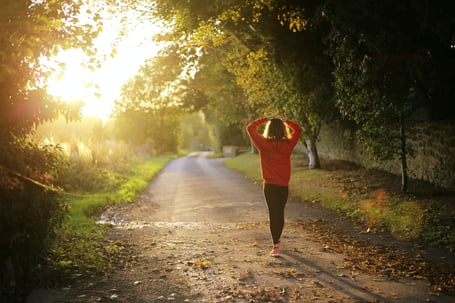
Benefits of Physical Activity
Regular physical activity is one of the greatest gifts you can give yourself. Staying active can bring a host of physical and psychological benefits, including
- Stress reduction
- Improved energy, mood, and sleep
- Enhanced cognition
- Better weight control
- Stronger bones and muscles
- Reduced risk of falls
- Reduced risk of many cancers and chronic illnesses
Overall, studies show that people who get about 150 minutes a week of physical activity have a 33% lower risk of death from any cause than those who are physically inactive.
Exercise-Related Pain
With a new exercise regimen, however, it’s common to experience aches and pains. When you move your body in a way it’s not accustomed to or exert yourself more than usual, your body takes notice! To keep your exercise routine productive and avoid causing damage to your body, it’s important to understand what kind of and how much soreness is normal and expected, what warning signs to look out for, and how to reduce your risk of injury.
Muscle Pain
When you work your muscles enough to gain strength, it’s normal to feel a mild (not intense) burn during exercise. Ideally, this should subside shortly after you’re done exercising. Many people, however, experience delayed onset muscle soreness (DOMS), which is typically most intense one to two days following exercise and subsides within four days. This is more common with a new exercise routine or when a familiar exercise is performed at higher intensity. DOMS is a result of damage to muscle cell membranes, which triggers inflammation in the area and leads to pain.
An appropriate warmup before exercise can reduce the risk of DOMS. Make sure your warmup routine includes both large-muscle movement that raises the core body temperature and targeted activities that gently introduce your body to the movements you will be doing in your main workout. The newer the workout is to you, the longer you should spend warming up to avoid overstressing your muscles.
Rhabdomyolysis
While mild muscle soreness is usually not cause for concern, the muscle tissue breakdown that causes DOMS can have serious, even life-threatening effects when it reaches extreme levels. When muscles suffer damage, they release an enzyme called creatine kinase (CK) into the bloodstream. At very high levels, this can trigger a condition called rhabdomyolysis (commonly referred to as “rhabdo” by athletes). Rhabdomyolysis can cause kidney damage, kidney failure, and in extreme cases, death. Warning signs include
- Severe muscle pain, especially in the legs, shoulders, and lower back
- Dark-colored urine
- Muscle weakness
- Difficulty moving arms and legs
- Nausea
- Confusion
- Fever
- Loss of consciousness
While muscle pain and weakness are common with rhabdomyolysis, the condition can be present even without muscular symptoms. If you suspect you may be experiencing symptoms of rhabdo, seek medical care immediately.
Rhabdo is rare, but your risk increases when you are dehydrated, taking non-steroidal anti-inflammatory medicines (NSAIDs) such as Advil or Aleve, or working out in a hot environment. To keep your risk low,
- Stay hydrated
- Ease into any new workout routine and avoid pushing yourself to your limit
- Avoid or minimize use of alcohol and NSAIDs
Tendon Pain
Tendons, which connect muscles to bone, can also become inflamed if they’re overworked, causing the condition known as tendonitis (also spelled tendinitis). Tendonitis can develop in various parts of the body, depending on the type of activity that caused the irritation. For example, jumping and squatting can cause tendonitis in the knee, and “tennis elbow” is inflammation of tendons in the elbow. Most often, this can be remedied with rest, ice, and over-the-counter anti-inflammatories, but further treatment for tendonitis may be necessary if the pain persists.
Fascial Pain
Fascia is the connective tissue that surrounds all our muscles, organs, nerves, and blood vessels. It’s made up of thin layers of tissue and liquid and when healthy, is slippery, flexible, and moves easily as you move. Runners, however, often suffer from a type of fascial pain called plantar fasciitis, which involves inflammation of the fascia in the heel. Therapies like massage, heat, and acupuncture can sometimes be helpful. In chronic cases, other treatments for plantar fasciitis may be needed.
Bone Pain
Bones will respond to excessive stress by building more bone. This is why weight-bearing exercise is advised to combat bone loss and prevent osteoporosis. If bones are overstressed, however, it can lead to pain along the bone during activity. It’s important to rest if you’re feeling bone pain, as continuing to put stress on the bone at this point can lead to a stress fracture. If not treated, the bone can break, causing severe injury.
These are just a few of the types of pain that people often experience as a result of physical activity. If you’re not able to determine the cause of your pain, if pain doesn’t subside after rest, or if it worsens, be sure to check in with your health care provider.
Resources
Benefits of Physical Activity. CDC.gov. https://www.cdc.gov/physicalactivity/basics/pa-health/index.htm. Updated April 5, 2021.
Campos Marcello, MD. Rhabdo: A rare but serios complication of… exercise. Harvard Health Publishing. https://www.health.harvard.edu/blog/rhabdo-a-rare-but-serious-complication-of-exercise-2018011113059. Published January 11, 2018.
Exercise: 7 benefits of regular physical activity. MayoClinic.org. https://www.mayoclinic.org/healthy-lifestyle/fitness/in-depth/exercise/art-20048389. Published May 11, 2019.
Maes Johndavid, Kravitz Len, PhD. Treating and Preventing DOMS. http://www.unm.edu/~lkravitz/Article folder/domos.html. Updated November 16, 2003.
McFarland EG, MD, Cosgarea A, MD. “Good Pain” vs. “Bad Pain” for Athletes. https://www.hopkinsmedicine.org/orthopaedic-surgery/about-us/ask-the-experts/pain.html. Accessed June 29, 2021.
Muscle Pain: It May Actually Be Your Fascia. HopkinsMedicine.org. https://www.hopkinsmedicine.org/health/wellness-and-prevention/muscle-pain-it-may-actually-be-your-fascia. Accessed June 29, 2021.
Plantar Fasciitis. MayoClinic.org. https://www.mayoclinic.org/diseases-conditions/plantar-fasciitis/symptoms-causes/syc-20354846. Published December 11, 2019.
Rhabdomyolysis. WebMD.com. https://www.webmd.com/a-to-z-guides/rhabdomyolysis-symptoms-causes-treatments. Medically reviewed March 17, 2021.
Tendonitis or Bursitis? ClevelandClinic.org. https://health.clevelandclinic.org/tendonitis-or-bursitis-your-best-treatments-begin-at-home/. Published May 14, 2014.

